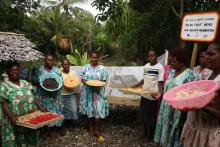Women take the lead on food preservation and climate change adaptation at the Nguna-Pele Marine and Land Protected Area Network

From the 5th to the 9th of November, 25 women from all around Nguna and Pele gathered in the village of Unakap on Nguna to attend a “solar dryer, food preservation and climate change adaptation” training.
The workshop was facilitated by local women from Nguna and Pele who have been successfully practicing the technique for over one year. The original technology and knowledge came from ni-Vanuatu expert Mr. Charles Long Wah supported by the SPC-GIZ Climate Change Program.
Vanuatu is known for its bountiful harvests of fruits and nuts (like mango, coconut, papaya and tamarind), but climate change is threatening these very important sources of food and income. Climate change and variability are already affecting the timing and success of flowing and fruiting of many of these crops. For example, this year’s mango season has been affected by the heavy rains caused by two consecutive La Nina events. Climate extremes can also cause trees to fruit early, late or not at all. The high vulnerability of our fruits and nuts to climate change makes them a great place to start adaptation activities.
In Vanuatu, very little value adding of products is undertaken. For example, when tomatoes are in season, the markets are flooded, prices drop and much produce is wasted. Only a few months later, no tomatoes can be found. Developing ways to store and preserve these excess fruits and nuts for use during cyclone periods when little food is available is a critical climate adaptation strategy. Some islands of Vanuatu have very well developed traditional food storage techniques, like the preservation of breadfruit in the Torres Islands, while others do not.
During this week’s workshop, the local trainers from the Nguna-Pele Marine and Land Protected Area Network took participants through the basic elements of fruit drying and value adding for the most valuable fruits and nuts. Giving detailed step-by-step instructions, the participants learned the intricacies of producing quality dried products for food security and even extra income generation. This 5 days’ workshop was divided in 3 phases: preparation, drying and packaging.
Preparation of the food by peeling and cutting with fish, tomatoes, eggplant, banana, pineapple, tamarin, chili, peanut, soursoup, papaya and mango.
Drying of food for a period of 3 days. Fruit Jams preserves were also prepared.
Packaging and selling of preserved food in the villages, specifically to help the women’s club.
The women of the training were extremely pleased with the simple and inexpensive technique. Indeed, there is now a real demand by individuals to build dryers and use their new skills. At the moment, there is 2 solar dryer on Nguna Island and 3 on Pele Island. The NPMLPA network will now further assess the
food security
needs and preservation opportunities around Nguna and Pele Islands to install more solar dryers.
The training was supported by a grant from the European Union , with materials and technical advice from the German Government through the SPC-GIZ Climate Change Program.
The participants with their preparation and a solar food dryer.
Food drying inside the solar food dryer.
A solar food dryer
